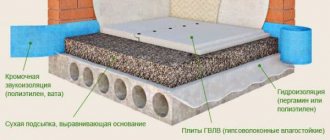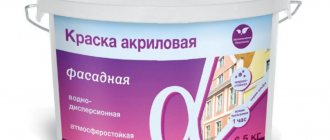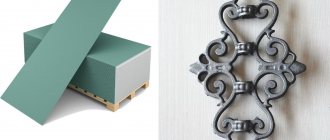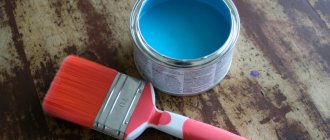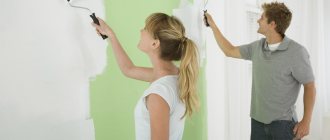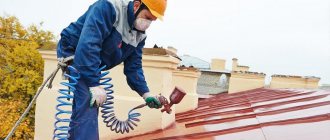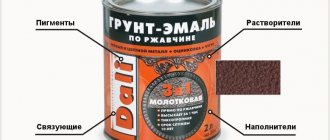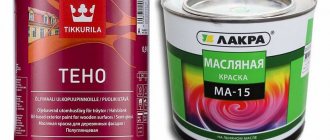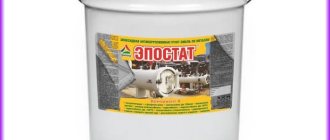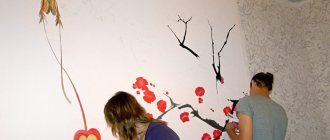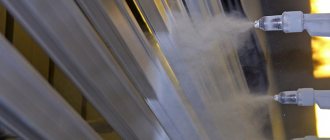Possible problems and their solutions
Various difficulties may arise when using powder pigments.
Technologists believe that the main cause of problems with powders is insufficient grounding of the surface prepared for painting. To avoid difficulties with grounding, it is recommended to check it in advance. The resistance value should not exceed 4 ohms. Poor grounding leads to the following consequences:
- Deterioration of sediment quality, decreased productivity of painting work.
- Failure to paint areas, causing defects.
- Increased powder losses leading to overconsumption.
- Deterioration in the quality of the formed layer, obtaining a “crust” effect, which implies translucence of the metal, and a tendency to develop cracks.
- Hand dyeing may result in electric shocks.
Many users note that they have problems with the material intended for work. Damp powder paint can clump, clog nozzles, and flow incorrectly onto the spray gun. This leads to the creation of an uneven layer, suspension of work or the creation of a defective zone.
Raw powder clumps if storage rules are violated or conditions are created for poor-quality air compression when starting work. To correct the situation, it is necessary to change the air compression indicator. Changing the pressure will stop the material from deteriorating.
Failure to paint the internal corners of parts with complex configurations is a problem that arises as a result of incorrect torch position. Approaching the gun muzzle too close to the corner being processed leads to blowing off of the powder, the formation of unpainted areas, and the appearance of gaps.
How to paint metal?
Suitable products are the key to success, so when working with metal bases, this factor plays the most important role.
Universal materials
Painting can be carried out by the following common types of products:
- Epoxy. For the manufacture of such compositions, silicone resins are used, which are supplemented with a hardener. Due to their high toxicity, they are used only for outdoor work. They differ in the complexity of application.
- Oily. A traditional option based on organic matter. Before treatment with this composition, the metal is pre-coated with primer. Due to the toxicity and pungent odor, parts can only be painted with good ventilation.
- Alkyd. They are in constant demand in cases where metal products need to be processed. Suitable for indoor and outdoor events. If the base is well prepared and has no problems, then the composition can be applied without prior priming.
- Acrylic. A modern polymer-based variety. Non-toxicity and ease of application make the material popular. The composition is suitable for painting metal surfaces subject to careful preparation.
- Rubber. Used for outdoor use, excellent for roofs or areas exposed to precipitation.
Rubber paint for metal is often used to finish galvanized roofing.
These solutions are considered classic and are used everywhere. The powder painting method stands out separately. It is complicated in that it requires the use of special equipment and tools.
Specialized options
To ensure reliability and durability, in some cases special materials are required:
- Compositions used in the presence of rust. They are an epoxy variety with special additives. They create a reliable film, preventing further destruction. They are applied without pre-treatment of the base directly to rusty areas.
- To prevent corrosion. Such materials provide the surface with additional protection from moisture and oxygen, that is, they do not allow parts to rust.
- Hammer compounds. They form an interesting decorative coating, reminiscent of traces of multiple hammer blows. They have good stability. Various base options are used for production: epoxy, acrylic, alkyd.
- Primer-enamel. A universal type of product that combines primer, corrosion protection and paint.
- Forging mixtures. Their production involves polymer compounds, which gives the coatings excellent wear resistance. Demonstrate good adhesion.
- Nitro paint. Sold in cans. It is highly toxic.
There are other types of coloring mixtures - varnish and enamel, which are used in the processing of stoves and other similar products. They belong to heat-resistant materials.
Consumption rates depending on the type of metal paints
The manufacturer's information will help you make the correct calculation of enamel consumption.
The manufacturer's information will help you make the correct calculation of enamel consumption. Each type of paint for metal work has a different thickness, elasticity and hiding power, which affects consumption rates. To determine the required amount, use a calculator to multiply the consumption per m² by the area of the surface to be painted and the number of layers. The following average figures for different types of coloring materials will simplify the procedure.
Important! 5% should be added to the resulting amount to avoid a lack of coloring composition when dyeing
Oil paint
When using oil paint, it is important to take into account the topography of the base when calculating the area. The color of the enamel also has a significant impact, since light colors are applied in 2-3 layers, which will increase the cost per meter of surface. The average consumption of oil paint per 1 m² is 130-140 g. for each layer.
Primer-enamel
An effective multifunctional product for interior and exterior painting – enamel primer. The coating acts as a primer and can transform rust on metal. Primer enamel is also a decorative layer. An average of 80-120 grams is spent per 1 m². material. To create a good protective layer against rust, the composition should be applied in several passes, which will affect costs.
Enamel PF-115
The composition based on alkyd resins is popular due to its fast drying speed and versatility. The paint consumption per 1 m² is affected by the degree of preparation of the base and the chosen shade. Light coloring compounds should be applied in several layers. According to professionals, a kilogram container is enough to paint 15 m². The consumption rate of PF-115 paint is 100-180 g. per square meter.
Powder paint
A special type of coloring materials, which differs in quality characteristics and application method. This affects material consumption. Powder dyes are designed to create a super-durable coating, so there are requirements for the thickness of the applied layer. It must be at least 100 microns. The weight of the mixture should also be taken into account. Less weight means less costs. Powder paint consumption per 1 m² for metal is 120-140 g.
Hammer paint
An expensive type of paint and varnish materials, which are often used for painting metal surfaces. The cost is due to its high protective qualities. With this composition you can reliably protect metal from rust. The coating resembles embossing in appearance. Paint consumption per 1 m² of metal is 100 ml.
Rubber paint
When applied to a metal surface, rubber paints and varnishes form an elastic coating resembling rubber. A layer of coloring composition effectively protects the metal from negative external influences. The cost of such products is high, the consumption is also increased to 200 ml per m². Such paints and varnishes are used for painting small surfaces that require special protection.
Acrylic paint
Painting materials based on acrylates have high protective characteristics. This coating is fireproof, weatherproof, and has a long service life. On average, 120-180 grams are used per 1 m². acrylic paint.
Powder paint consumption per 1m2
Painting involves applying a powder dye to the object to be painted. The material dissolves under the influence of polymerization, due to which it is able to evenly cover the object being painted.
The powder coloring agent is applied only once, since its layer is the same thickness as 3 layers of any other coloring agent.
Its big advantage is durability - the painted object receives maximum protection from external influences, such as temperature changes, chemicals, corrosion and mechanical damage.
You can find a wide range of powder paint mixtures, including polyester-epoxy and polyester paints. When choosing, you should consult a specialist who can select the quantity and composition based on your needs.
It is worth choosing powder coating because its properties are superior to traditional paints. Powder painting is suitable for painting small metal objects, such as:
Powder paint consumption information.
- gates;
- ladder;
- railings;
- accessories and auto parts;
- alloy wheels;
- bumpers for SUVs;
- bicycle frames;
- car parts and car bodies;
- Appliances;
- electrical equipment housings;
- racks;
- radiators;
- lamps;
- façade elements;
- gutters;
- window sills;
- metal garden furniture.
The average consumption varies within 140 grams per square meter. But it can differ significantly from the original one under the influence of various factors, including the size and shape of the surface, its evenness, the method of application and the type of coloring matter.
- Size. First of all, it is necessary to calculate the area of the surface to be painted. If the surface has curves, the flow rate may increase.
- Evenness is an important factor when calculating material consumption. The smoother the surface, the less paint will be needed. Therefore, before painting the product, it is necessary to sand it to a shine.
- Method of application. Experts advise applying paint using a spray gun. This application method allows you to reduce the amount of material used by almost 2 times.
- Variety. Consumption depends on the type of paint. Manufacturers indicate the consumption and weight of the coloring composition on the container in which the paint is located. If you follow all the rules when painting objects, the consumption will differ little from that indicated on the packaging by the manufacturer.
What affects consumption?
There is virtually no waste with powder coating. The crumbled powder in the spraying chamber is collected and reapplied without loss of quality. The approximate consumption of powder paint is usually indicated by the manufacturer on the product packaging. Special calculation formulas are also given here.
- Powder paint consumption per 1m2 depends on many factors:
- composition and size of material granules;
- type of surface being formed (smooth or textured);
- specific gravity of coloring powder;
- thickness of the polymer coating film layer;
- quality of surface preparation;
- professionalism of the master.
When using powder paint, the consumption per square meter depends on what functions the coating should perform: protective, decorative or protective-decorative.
In addition, the complexity of the structure being painted affects the consumption of powder paint per 1 m2 applied to metal. Flat, smooth products will require much less paint than shaped and complex parts with hard-to-reach places.
To calculate the approximate powder consumption per square meter, the thickness of the applied layer should be multiplied by the specific gravity of the paint. The average paint consumption is from 100 to 140 grams per 1 m2. When making calculations, it is necessary to take into account factors affecting powder consumption.
When working with powder paint
After passing through powder coating equipment, the products obtain excellent decorative and anti-corrosion properties. The material savings here are almost 100% (paint that has not settled on the surface can be used again). Modern lines of equipment for powder coating and decorative finishing of metal are fully automated.
Among the advantages of powder over enamels, they note the greater strength of coatings to mechanical stress (for impact - 100 kg/m, for bending - 4-6 mm). It is also worth mentioning the increased adhesion (adhesion of the powder to the surface - 500 kg/nm). The coating improves the anti-corrosion characteristics of the product. It can withstand solutions of alkalis, acids and organic solvents.
Items painted with powder paint can work in the range of -60°C… + 150°C. The thickness of the coating can be from 0.05 to 0.3 mm. The produced paints of this type are available in all colors according to the RAL map. Based on the type of film formation, they are divided into several main groups:
- epoxy;
- polyester;
- epoxy polyester;
- polyamide.
With their help, glossy and matte surfaces can be formed.
Working with powder is more environmentally friendly because it does not release vapors of liquid solvents. Equipment for powder coating does not require preliminary priming of products. To apply the coating, it is enough to pass the products through the painting line once.
This method provides production with a reduction in overall energy costs by 20-40%. The dyeing process becomes faster and less labor-intensive. It is almost completely safe for personnel and does not require spacious premises. The conclusion is obvious: powder paints are more profitable to use than liquid paints in many respects.
Powder paint consumption during application
The perfection of powder painting technology (painting with polymer powder paint) lies in achieving the best quality of polymer coating at the minimum cost of powder coating in full compliance with environmental requirements. The share of powder paint in calculating the cost of painting a square meter in the industrial cycle is about 65 - 70%. Therefore, it is very important to spray the polymer coating using a minimum amount of paint. Using the example of painting office chairs, the theoretical consumption of powder paint and the cost of 1 m2 of polymer coating can be calculated using the following formulas:
As can be seen from the calculation formulas, the consumption rates of powder paint during application depend on various factors:
| • | The thickness of the film affects the performance qualities of the polymer coating, in addition, it determines the consumption of powder paint, accordingly, it is important to control it. It depends on the type of surface being formed (structured or smooth), as well as on the required properties of the polymer coating (decorative, protective or protective decorative). Decorative polymer coating requires modern powder paints with good hiding power, which provide the possibility of painting with a layer thickness of 40 - 50 microns. Protective and decorative polymer coatings require an optimal coating thickness of 70 - 100 microns. Protective polymer coatings must have a thickness ranging from 90 to 130 microns or more. |
| • | Fractional (granulometric) composition . The size distribution of powder paint particles can affect the flowability, characteristics of the coating and its appearance. The polymer coating is characterized by the particle size of the main fraction; this indicator is responsible for the thickness of the applied layer. |
| • | Specific gravity of paint . The lighter the paint, the less it is consumed for the same coating thickness. Ideally, with a specific gravity of 1.2 g/cm3 and a coating thickness of 80 microns, you can achieve the consumption promised by powder paint manufacturers of 100 g/m2. But, unfortunately, this is only ideal; in practice, for most industries this figure is on average about 120 - 140 g/m2. |
| • | Human factor . Despite all the perfection of paint sprayers, the influence of the human factor remains when manually applying powder paint. In this way, a polymer coating is obtained with a thickness that depends on the concentration of the powder in the spray jet, the time of passage of the product through the spray jet, as well as on the degree of charging and paint deposition coefficient. A highly qualified painter can provide a significant reduction in paint consumption by up to 10 - 15%. |
| • | Shape and complexity of painted products. The uniformity of the thickness of the polymer coating for flat panels or complex parts will be different, and accordingly the paint consumption rates will be completely different. |
When choosing powder paint, you must be guided not only by price, the main thing is that the polymer coating obtained from it satisfies the consumer’s requirements to the maximum extent - appearance, durability of the coating and warranty period. Manufacturers of powder paints have the opportunity to individually, taking into account all the requirements and wishes for the properties of the final product, select the optimal paint composition to ensure the best coverage and minimize consumption standards when applying a polymer coating.
Based on materials from https://euroimpianti.com.ua/articles/rashod-kraski.html
Required materials and equipment
So, let's give a detailed description of the technology of powder coating of metal. To create a durable coating layer on it you will need:
- oven (chamber) for polymerization: you can make it yourself or purchase it in a specialized store;
- spray gun: since such a device costs a lot, it can also be assembled from a converter, often used in lighters for gas stoves, a power supply and an ordinary plastic bottle;
- naturally, the paint itself.
Drying ovens will need to be connected to a voltage source of 25 kW. In operation it will produce 6 kW, while warming up a little more - 12 kW. To make it, you will need thick sheet metal for the housing, heating elements, a tangential fan in which air masses will move in one direction, as well as any non-flammable heat insulator for the casing.
The heating elements are placed parallel to each other on opposite walls of the furnace. The main part of the fan is mounted outside the chamber. It is welded in such a way that the exit is narrow and the entrance is wide enough. It is also necessary to make a separate chamber for spraying in the drying oven. For processing large parts, it is better to provide rail-type trolleys.
Methods of working with powder paint
Although the powder coating method has been known for quite some time, its technical development began relatively recently. During this time, several ways to carry out the process have emerged.
- Electrostatic spraying is considered the most popular and widespread. The principle is that powder particles acquire an electrical charge as they pass through the atomizer. In this case, the treated coating remains electrically neutral. It is this difference that creates an electric field, due to which the powder is attracted to the surface and held firmly. This is the first stage of painting. Next, the processed part is placed in a special oven, where it is heated at a temperature of about 200 degrees. Short-term exposure melts the top layer, and it is reliably absorbed into the base. The electric charge gradually disappears.
- A more complex method is one that involves preheating. That is, the metal product being painted is heated to a certain temperature (the indicator is selected individually). Using a sprayer, powder paint particles are applied to the base and melted. Further actions do not always involve reheating and depend on the type of coating applied.
- For the third option, predominantly thermoplastic powder is used. The work uses a special spray tool, which is equipped with a chamber with burning propane. Preheated particles hitting the surface form a durable protective layer. Although this technology allows the coloring of various materials, its distribution is relatively small.
The demand for the first painting method is explained by the fact that this option has greater technological development. With other methods, everything is more complicated: the second method requires careful selection of temperature, and the third appeared relatively recently.
Factors affecting powder paint consumption
When calculating powder paint consumption per 1 m2, the following factors must be taken into account:
- Layer thickness. This factor affects not only the quality characteristics of the powder coating, but also directly determines the consumption. The thickness of the applied layer depends on the type of surface to be painted and its functional purpose. So, for a regular decorative layer it is enough to apply paint in a layer of up to 50-80 microns, for a protective one - a two-layer coating with a thickness of each layer of 80-100 microns.
- Faction composition. This indicator is responsible for the thickness of the applied layer, since the flowability of the coating depends on the paint particles. Very fine particles settle unevenly on the product and accumulate in parts of the equipment, which increases its consumption, so the paint fraction should have an average size of 50 - 75 microns.
- Technical condition of the equipment. High-quality and, most often, foreign technical equipment allows you to reduce consumption. This indicator is also influenced by proper operation and timely maintenance of the spray gun. All this helps reduce consumption by several percent, which brings considerable savings for large volumes of painting.
- Human factor. An experienced powder coating specialist can reduce the amount of material consumed by almost 10 - 15%.
- Type of surface to be painted. The consumption of powder paint also depends on the type of surface. The minimum amount of material will be required for processing smooth metal or plastic products, and the maximum for processing wooden, concrete and perforated surfaces. The amount of required material also increases when working with gratings, complex and composite parts.
- Other factors that determine powder paint consumption. Other factors include the type of paint, its composition and manufacturer.
Based on all these factors, you can calculate the approximate consumption of the required material. However, it is better to purchase coloring powder compositions with a small reserve and be guided not only by the price, but also by the appearance, performance properties and composition of the product.
Home painting - technology for working with powder paints
Preparation stages:
Cleaning. Any method necessary for a particular case is suitable:
- mechanical - with a grinder, brush, rag...;
- chemicals (solvent, acid, alkali);
- To remove rust, you can do abrasive cleaning (in a sandblaster) or treat the surface with a special compound (metal cleaner).
Primer with inorganic paints. A conversion layer is applied - protection against moisture, air, and dirt getting under the film.
Passivation. The product is treated with a sodium compound, chromium 3 nitrate or phosphated, which prevents secondary oxidation of the metal.
The last step in preparing for painting is to rinse, dry and cool the part. The product is ready. You can start painting.
In a special spraying chamber, dye powder is applied to the object being processed, which must be grounded, for which an electrostatic gun (spray gun) is used. The part must be positioned so that it can be accessed from all sides. Due to the difference in electrical charges, dry paint particles “stick” to the surface of the workpiece.
The next stage is baking and polymerization of the paint. The painted product is placed in the oven. The main process will take place there - melting and formation of the film layer. The processing time and temperature depend on the composition of the dye. They must be indicated on the packaging. The material of the product being painted and the conditions under which it will be used are also taken into account.
The last point is that the product must cool completely.
Oil Paint Consumption per 1m2 for Metal
Calculation of oil dye for metal, calculated in grams, is the most convenient indicator, since most often we know information about the surface area in advance. The area needs to be calculated, taking into account all the unevenness, the level of absorption, how many layers need to be applied.
Among the most significant factors determining material consumption, color should also be highlighted. The number of layers and quality of the coating will depend on this. Since color density depends on pigmentation, costs will vary depending on the tone.
Oil paint consumption rates
The standard calculation of material when painting in one layer is 130-140 g per 1 m2. Light-colored paints have a lower density, which increases their consumption, meaning the surface will have to be painted in two or three layers.
The table shows the calculation of oil dye depending on color:
| Paint color | Coverage area with 1 kg |
| White | 6-10 m2 |
| Yellow Red | 5-10 m2 |
| Green | 10-14 m2 |
| Blue | 11-16 m2 |
| Brown | 12-17 m2 |
| Black | 17-20 m2 |
How to paint with powder paint
After all the equipment has been assembled, purchased and adjusted, you can paint the metal parts yourself.
Paint selection
Powder paints are divided into two categories:
- Thermoplastic. The principle of obtaining the coating is that the powder is applied to the part that is being baked. The created layer is only affected by temperature. This group includes compositions based on polyvinyl butyral, polymers, polyamide, and polyefin.
- Thermosetting. The essence of the process is that fusion is accompanied by a certain chemical reaction. This allows you to obtain a surface that is resistant to any impact. Options for such mixtures: epoxy, polyester, epoxy-polyester, polyurethane.
Please note that the color of the selected paint is not tinted.
Both thermoplastic and thermoset compounds come in a wide range of colors
Dyeing technology
Housework requires the creation of certain conditions. All processes are distributed across areas to prevent disruption of the painting technology due to dust and dirt.
Procedure:
Metal processing is carried out. The surface is thoroughly cleaned of the old layer. If traces of blackening or bluing are observed, the coating must be completely removed.
Cleaned parts are degreased and thoroughly dried. If required, phosphating is carried out. Areas that do not need to be painted are covered. The processed product is placed in the spray booth and grounded. To do this, it is hung on hangers. Hooks should not interfere with the uniform distribution of the composition. Using a gun, powder is sprayed onto the surface of the part.
Care must be taken as the composition can be easily rubbed off when touched. If this happens, a new coat will need to be applied.
For this, the best solution would be to have a mobile attachment.
After processing, the product is placed in the oven. The required temperature regime is selected, the heating process lasts from 10 to 30 minutes. To paint the product correctly, you need to observe the temperature for each layer: if a primer is applied, then it is about 150–160°C, for a base coat – 170–180 degrees, and for a base coat – more than 190°C. Naturally, the indicators depend on the material and size of the part. After baking, the product is removed from the oven. For complete adhesion of the paint, it is recommended to wait a day.
Naturally, to obtain the optimal result, it will take some time to correctly configure all the equipment and develop a clear sequence of the technological process. But if all conditions are met, the result will exceed all expectations.
Powder paint consumption rates are calculated using the formulas
Powder paint is increasingly gaining popularity, displacing traditional liquid paints from the market everywhere. And first of all, this becomes possible due to the fact that powder paint consumption rates much less, which reduces painting costs.Naturally, a person who has decided to purchase an automatic powder coating line is primarily interested in the economic question, namely, what are the cost standards for powder coating, the price of paint, and the cost of the process itself. You can read on the Internet that the acceptable rate of paint consumption per square meter is about 80-90 grams. But there are also those who say the exact opposite, they say that this is impossible and the norm is much higher.
In order to understand whose statements are as close to reality as possible, we can take a general example. Indeed, the most common and used standard of powder paint (if you do not take into account structured materials) assumes a normal consumption rate on flat surfaces in the range of 150-180 grams without perforation. Accordingly, if there are perforations, coils, gratings, as well as complex parts and shapes, then the consumption rate can increase quite seriously - somewhere between 2-33 times. Therefore, those people who claim that the consumption of powder paint depends on the thickness of the applied layer are right.
Where did the talk about the very low consumption of powder paint come from? There is only one answer here - these are completely different powder paints, which are not used everywhere, and are almost not advertised. And although there are several reasons for this “shyness,” the main one is that it contains mainly very small fractions, which at the same time is both a plus and a minus. The negative factor is that such paint is very harmful for people involved in the painting process (in fact, for this reason it is not advertised). In addition, high-quality painting of complex surfaces and corners becomes difficult. As for the advantages, these are indeed very low consumption rates for this type of powder paint. So, for smooth paints the consumption is 70-80 grams per square meter, and for shagreen paints - 90-100. This consumption was obtained in the process of small-scale dyeing and using imported paints - Italy, Korea, Turkey, Poland, Finland. As a rule, it is almost impossible to find advertisements for these paints, and their rates are carried out on a special request. And if you still want to purchase such powder paint, then when searching you need to include in your request the wording about reduced consumption rates and increased spreadability.
But it should be said that recently powder paints with reduced consumption rates, in which the content of fine fractions has been reduced (although not reduced enough for complete safety), have begun to appear on the domestic market. According to manufacturers, their spreadability is very high.
By the way, approximate consumption rates for powder paint are usually indicated by manufacturers on the packaging of the material, and they also provide special formulas by which you can quickly calculate everything. But still, the calculated consumption rates depend on many circumstances. First of all, it depends on the thickness of the applied layer, which is quite natural. Want better coverage? Then more paint will be needed, which will increase consumption. Also, the type of surface of the product that is subjected to powder coating has a great influence - on a smooth surface the consumption is less, on a structured one, the rate will accordingly increase. And of course, you need to take into account the type of coating you want - protective, decorative, or decorative-protective.
But when choosing powder paint, it is recommended to be guided not only by its cost and consumption rates, but to proceed from the goal of obtaining a high-quality and attractive coating as a result of painting. After all, this is the main thing. It is very important that painted products maximally satisfy consumer expectations - have an attractive appearance, durable coating and are able to last for at least the warranty period.
See also:
- There are two types of powder paint recovery system
- Thermoplastic powder paints come in several types
- Fluorescent powder paints are a good option for interior decoration
Back
Required Equipment
In order for the process of self-painting to be practically no different from the factory one, it is necessary to choose a suitable place where the work will be carried out.
When the premises have been found, you need to collect and prepare the necessary equipment:
- oven for polymerization (drying);
- constant voltage source (about 25 kV);
- powder paint sprayer (gun);
- LMB.
Accuracy and a little experience will not hurt in the work. But if it’s not there, it doesn’t matter; by following the instructions, you can avoid most mistakes and get quite a decent result.
Making a furnace
Polymerization is an important step in the hardening of powder paint. If this item of work is omitted, the paintwork will not adhere to metal surfaces. Therefore, equipment such as a furnace - also called a polymerization chamber - is necessary first of all. This thing is expensive, so you can make it yourself, from scrap materials. We will need (the polymerization chamber will have dimensions of 2x1x1 m):
- profile pipe;
- non-flammable thermal insulation (basalt slab);
- sheet metal (can be ordered by size);
- tangential fan;
- Heating elements.
The oven assembly instructions consist of the following steps:
- Weld a frame from the profile.
- Put insulation in it.
- Cover the walls with sheet metal. Finish the outside with gypsum fiber.
- For convection in the chamber, install a tangential fan, welding it with a narrow outlet and a wide inlet.
- Insert the fan into the chamber. It will take in air at the top, drive it through the heating elements, expel it at the bottom, and then distribute it throughout the entire volume of the chamber.
- Install the heating elements along parallel walls and connect them according to phase distribution.
- Close the heating elements, leaving the fan open, the main part of which should be located outside the chamber (so as not to melt the winding).
- Install an electrical panel. True, it is better to entrust this work to a specialist.
The resulting equipment - a polymerization chamber - will have a power of 12 kW when warming up and 6 kW in operation.
Important! The energy source in such ovens for drying powder paint can be not only electricity, but also natural gas and diesel fuel
Painting tool - gun
To apply powder paint to a product, a special device is required. This is an electrostatic spray gun or a tribostatic powder spray gun. But buying expensive equipment for rare use is not advisable. Since in our case everything is made by hand at home, such a device can be made in about 10 minutes. Such a gun is easy to use, cheap and practical. The transition from one paint to another takes a few seconds.
Design and equipment of a gun for powder paintingHow to make a powder paint gun:
- Take a regular plastic 1.5 liter bottle. The main thing is that it is dry and clean.
- Fill it 1/3 with powder paint, screw it with a metal plug.
- Make small holes in the cork. The more holes, the better the application. Clean the outside of the plug from any burrs left after piercing.
- Connect the positive wire from the high-voltage source to the plug.
For this purpose, you need a converter that can deliver 25,000 volts DC. These are used in stun guns, lighters for gas stoves, boilers and speakers. They can be powered by batteries or accumulators, converting 3-6 volts into the required 25 kV.
Use caution when working with high voltage. It is better to have the converter assembled by a qualified electrician.
After all the manipulations, you get a pretty decent pistol.
Little things you can't do without
Before starting painting, you need to carefully ensure that all operations take place under ideal conditions:
- Excellent lighting is essential. Use fluorescent lamps. Powder paint adheres perfectly to a regular lamp.
- You need good ventilation with two motors (inlet and outlet). Additionally, you will have to wear a gauze bandage, or better yet, a professional respirator.
- We will have to invent a way to collect the remaining powder paint. In the initial stages, use an old powerful vacuum cleaner.
When everything is carefully prepared, you can start painting the necessary parts yourself.
Paints and varnishes - production
The perfection of powder painting technology (painting with polymer powder paint) lies in achieving the best quality of polymer coating at a low cost of powder coating in full compliance with environmental requirements. The share of powder paint in calculating the cost of color per square meter in the industrial cycle is about 65 - 70%. Therefore, it is very important to spray a polymer coating using low paint consumption. Using the example of the colors of office chairs, the theoretical consumption of powder paint and the price of 1 m2 of polymer coating can be calculated using the following formulas:
As can be seen from the calculation formulas, the consumption rates of powder paint during application depend on various reasons:
| • | The thickness of the film affects the performance properties of the polymer coating; in addition, it determines the consumption of powder paint; therefore, it is important to keep it under control. It depends on the type of surface being created (structured or smooth), as well as on the required parameters of the polymer coating ( decorative, protective or protective-decorative). Decorative polymer coating requires modern powder paints with good hiding power, which provide the possibility of coloring in a layer 40 - 50 microns wide. Protective and decorative polymer coatings imply a better coating height of 70 - 100 microns. Protective polymer coatings should be 90 - 130 microns wide or more. |
| • | Fractional (granulometric) composition. The dispersion of powder paint particles by size can affect the flowability, properties of the coating and its appearance. The polymer coating is characterized by the particle size of the main fraction; this indicator is responsible for the thickness of the applied layer. |
| • | Specific gravity of paint. The lighter the paint, the less it is consumed for the same coating thickness. As a standard, with a specific gravity of 1.2 g/cm3 and a coating thickness of 80 microns, it is possible to achieve the consumption promised by powder paint manufacturers of 100 g/m2. But, unfortunately, this is only a standard; in practice, for most industries this figure is on average about 120 - 140 g/m2. |
| • | Human factor. Despite all the perfection of paint sprayers, there remains the impact of the human factor when manually applying powder paint. In this way, a polymer coating is obtained with a width that depends on the concentration of the powder in the spray jet, the time of passage of the product through the spray jet, as well as on the degree of charging and paint deposition coefficient. The highest qualification of the painter can provide a significant reduction in paint consumption by up to 10 - 15%. |
| • | Shape and complexity of painted products. The uniformity of the thickness of the polymer coating for flat panels or complex parts will be different, and accordingly the paint consumption characteristics will be completely different. |
When choosing powder paint, you need to be guided not only by price, the main thing is that the polymer coating purchased from it best meets the consumer’s requirements - appearance, durability of the coating and warranty period. Manufacturers of powder paints have the opportunity, on a personal basis, taking into account all the requirements and wishes for the properties of the final product, to select the best paint composition to ensure better coverage and minimize consumption standards when applying a polymer coating.
Choosing paint
After we have prepared the equipment, the most crucial moment comes - choosing paint. Today there are a huge number of types, brands and colors of powder dyes. We need to figure out what material we need. When painting discs with your own hands, use the following types of paints:
- epoxy;
- polyester;
- polyurethane;
- silicone.
Epoxy paints are resistant to alkali and acids. Polyester is considered to be anti-corrosion. Polyurethane - resistant to abrasives and solvents. Silicone - can withstand even the highest temperatures.
The most famous paint manufacturers: Pulverit, Infralit, P-EP 45, Bichon, TFK, Beckers, Radar, Inver, Flycoat. Using the products of these companies, you can create a completely unique disc design with your own hands. It is possible not only to choose a color, but also to change the texture of the discs: from matte to glossy.
With the help of some types of paints it is possible to change the structure of the coating with your own hands. Shagreen, moire, antique and other types of textured paints are available for sale. The range of colors is determined by the RAL standard.
Powder painting of wheels at home requires special clothing.
Consumption
The attractiveness of powder paint is beyond doubt. However, you need to accurately determine the need for it, find out how much coloring composition is used for each m2. The minimum thickness of the created layer is 100 microns, to reduce the use of dye, it is advisable to spray it. The aerosol method of application allows you to spend from 0.12 to 0.14 kg of material per 1 square meter. But all these calculations are only approximate and allow us to determine the order of the numbers.
An accurate assessment can be made by knowing the properties of a particular type of paint and the characteristics of the substrate on which it will be applied. Remember that the standard indicated on labels and packaging, displayed on advertising posters, implies painting a surface that is absolutely free of pores. Plastic or metal has only slight porosity, and therefore even when painting them, you will need to use a little more dye than prescribed by the manufacturer. When other materials need to be processed, costs will increase significantly. So don’t be indignant when you find “inflated” numbers in your bills for powder painting services.
Powder paint
Powder polymer paints have become increasingly popular lately. And no wonder. After all, with their help you can obtain a finish with properties that are completely impossible to achieve using conventional liquid compositions. Films created by such dyes can withstand truly colossal loads. So, what is the rate of paint consumption per 1 m2 when using a powder composition?
The calculation is made based, first of all, on the weight of the product and the thickness of the applied layer. The “lighter” the paint, the less it is needed to obtain a high-quality coating. The thickness of the protective and decorative layer should be at least 100 microns. As practice shows, when using a sprayer for painting, in this case approximately 120-140 grams are used per 1 m2 of surface. facilities.
